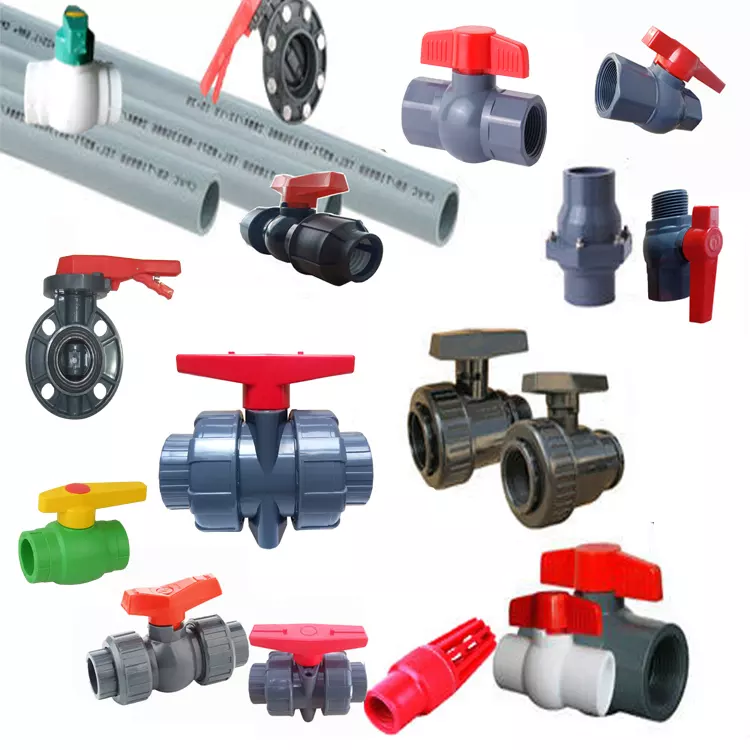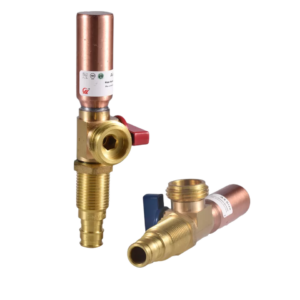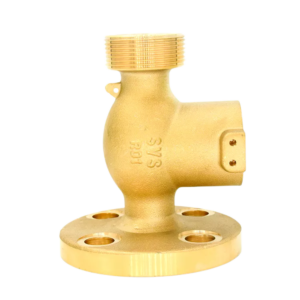Description
PVC Compact Ball Valve
Full Flow 200 PSI
JX-0758B
- Connection: Socket/thread both types
- Size: 1/2″-4′
- Max Temperature: 140F
- Seal Material: EPDM
- The water pressure is 200 bar
Glue the inserted end to the pipe
- Application: The construction of a plumbing system
- Material: HPVC heavy-duty design, acid, and corrosion resistance
Compact PVC ball valves are made utilizing the molded-in-place process. Multiple advantages result from employing this novel technique, which involves molding the plastic around the ball and stem assembly. A whole port ball is utilized; however, including it from one results in the absence of seams in the valve. This results in a more robust and compact valve that does not impede the flow. These solid and inflexible valves find utility in a wide range of water supply scenarios. A compact PVC ball valve is an exceptional option for an economical valve.
Structure of PVC Ball Valves

A multitude of plastic molding techniques are employed in the fabrication of PVC ball valve housings. The enclosure and ball are separately shaped and subsequently joined during assembly.
Valve Structure
The valve body comprises every component of the PVC ball valve utilized to activate or deactivate the flow.
The spheroid has a central nucleus through which media passes. PVC ball valve spheres are available in two, three, and four-way configurations. The stem’s rotation establishes the flow’s direction.
Please read our article on: What is Ball Valve
Stem Mechanism
As the external control mechanism, the stem is affixed to the tip of the ball and can be used to regulate the flow manually or automatically by quarter-turning the ball.
Seats for PVC ball valves
The configuration of the seats on a PVC ball valve varies by valve type. They constitute the lining that separates the ball from the valve body. The seating seals the space between the ball and the valve body. An extensive range of seats are utilized in the sealing and separation procedure, among which EPDM synthetic rubber is considered.
Packing
Packing is least often utilized to prevent leakage. It serves the same purpose as PVC ball valve seats: to seal the valve’s contents. Packing may be in the shape of O rings and is affixed to the valve’s stem. The flexible closure formed by packing around the shaft prevents the media from escaping.
Plastic Retainer
While porous plastic handles can also be utilized, solid plastic handles are necessary to operate PVC ball valves manually. The handle, which is attached to the stem, facilitates the manual rotation of the ball. UV-resistant coatings and materials are applied to the handles to prevent deterioration caused by sunlight exposure.
When to Use PVC Compact Ball Valve?

The compact ball valve is predominantly employed in non-industrial applications such as irrigation systems, water supply, septic tanks, and wastewater systems. Valves are pressure-tested at 150 PSI and can withstand temperatures as high as 140 degrees. Compact PVC ball valves are sealed at the ball. Seals are offered in EPDM or Viton to accommodate particular application requirements. Operating an on/off media flow system, the compact ball valve is engineered to be an exceptionally economical pipe valve.
Standard Sizes:
1/4 inch: Suitable for smaller applications, often found in home aquariums or similar setups.
1/2 inch: Commonly used for household plumbing tasks, garden irrigation, and other small-scale applications.
3/4 inch: A frequent choice for domestic water supply lines and garden hoses.
1 inch: Used in larger domestic systems and small industrial applications.
1 1/4 inches: Typically found in bigger residential setups and light industrial applications.
1 1/2 inches: A standard size for various medium-scale residential and industrial applications.
2 inches: Often used in industrial settings, larger residential systems, and commercial buildings.
2 1/2 inches
3 inches
4 inches
How To Open And Close PVC Ball Valve
Now, let’s dive into the steps to make a PVC ball valve open or closed:
Opening the PVC Ball Valve:
- Find the handle on the ball valve. It’s usually on the side or top of the valve.
- Make sure the handle is straight across from the pipe. This means the valve is closed.
- Slowly turn the handle backward until it is straight across from the pipe.
- The ball inside the valve will move as you turn the handle. Putting it in line with the flow and letting it go.
- Make sure the handle is now straight across from the pipe. This shows that the ball valve is indeed open.
Closing the PVC Ball Valve:
- Look for the valve handle. It should be straight, which means the ball valve is open.
- Turn the handle counterclockwise until it is straight out from the pipe.
- When you turn the handle, the ball inside the valve will turn 90 degrees and stop the flow.
- Make sure the handle is straight across from the pipe. This means the valve is closed.
- Ensure the flow stops and the PVC ball valve is shut firmly.
Read our post on: Types of Ball Valve

PVC Compact Ball Valve Properties
The following enumeration presents a comprehensive synopsis of significant attributes of the material:
- Durable, lightweight, and lengthy in service
- Environmentally minimal in comparison to alternative plastics; recyclable.
- No corrosion
- Many compounds, acids, and bases are resistant to it.
- They are utilized frequently in sanitary applications, including potable water. Most DN50 PVC ball valves are PN16 (16 bar at room temperature) at maximal pressure.
PVC Compact Ball Valve Selection
It is advisable to contemplate the subsequent selection criteria before choosing the PVC compact ball valve that is most suitable for your given application:
Bore Design
Although the two-way PVC valve is the most prevalent, alternative bore configurations can help optimize an application’s performance. The T port and L port configurations found in three-way bore designs are advantageous in situations involving fluid flow’s blending, distribution, and diversion. These bore designs can be extremely beneficial when dealing with various fluids and flow types.
Media
Corrosive media that can damage other substances are compatible with PVC ball valves, including saline water, acids, bases, salt solutions, and organic solvents. Understanding a medium’s attributes is a fundamental component of selection.
Temperature Change
When selecting PVC compact ball valves, temperature must be accurately considered, as it is a central factor in numerous manufacturing applications. PVC has a melting and yielding point that is comparatively low, between -15 and 60°C.
PVC is susceptible to degradation and alteration under specific conditions; therefore, the chemical structure of the PVC material dictates the selection of a PVC ball valve.
Pressure Effect
Pressure, like temperature, significantly impacts the suitability of a PVC ball valve for a given application. Similarly, the structure of the PVC may prove decisive in this instance.
PVC valves have extensive applicability in diverse residential and commercial settings. Typical applications for PVC compact ball valves include the following:
- Domestic irrigation
- Chemical processing
- Food processing
- Water treatment
- Water features and fountains
- Aquariums
- Landfills
- Swimming pools






